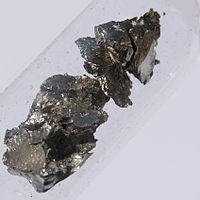
Photo from wikipedia
Most praseodymium-doped red-emitting phosphors need high-temperature synthesis conditions with a reducing atmosphere. The niobate matrix selected in this work provides a sufficient electron-rich-site environment for praseodymium through charge migration, and… Click to show full abstract
Most praseodymium-doped red-emitting phosphors need high-temperature synthesis conditions with a reducing atmosphere. The niobate matrix selected in this work provides a sufficient electron-rich-site environment for praseodymium through charge migration, and praseodymium can be self-reduced in air atmosphere, which is safe and environmentally friendly. By building the [NbO6] group → Pr3+ energy transfer and finely modifying the doping concentration of Pr3+ ions, we constructed a dual-luminescence-system of the [NbO6] group and Pr3+. Thereby, optical temperature measurement based on fluorescence intensity ratio (FIR) technology of Pr3+ ions and [NbO6] groups was carried out using non-thermal coupling pairs, through the Boltzmann fitting and integral calculation, the maximum Sr and Sa values were 2.25% K-1 and 0.0049 K-1 at 403 K and 443 K, respectively, the Sr value is four times that obtained from the thermal coupling of Pr3+ ions, which exceeded most values previously reported for the fluorescence powder. Accordingly, we also studied the thermal sensitivity of Er3+ ions and Eu3+ ions mono-doped CaNb2O6 substrates. Results reveal that CaNb2O6:Pr3+/Er3+/Eu3+ phosphors have splendid temperature sensitivity and have far-reaching application prospects in the field of temperature measurements.
Journal Title: Dalton transactions
Year Published: 2021
Link to full text (if available)
Share on Social Media: Sign Up to like & get
recommendations!